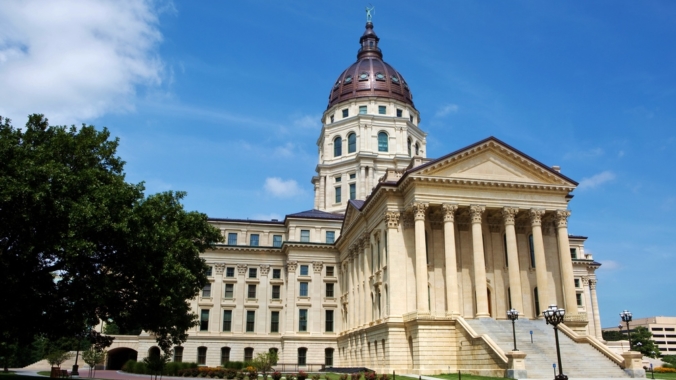Bleeding Kansas and Four Constitutions
LISTEN ON SOUNDCLOUD:
The state and constitution of Kansas was born amid arguably the most contentious controversy than any other state. The 1850s witnessed fierce national debates over slavery and its expansion westward with such key events as the Compromise of 1850, the furor over the Fugitive Slave Act and slavecatching, the Dred Scott (1857) decision, the Lincoln-Douglas debates, and the Harpers Ferry raid. These and the violent and bloody birth of Kansas helped spark the descent into the destructive Civil War.
The Kansas controversy originated in the Mexican War and the peace treaty ceding an immense tract of land to the United States in the West. Partisan and sectional arguments tore at the nation’s political system as proposals such as the Wilmot Proviso offering to ban slavery in all the territory acquired from Mexico. Finally, the congressional statesmen engineered a compromise in 1850 to save the republic which included “popular sovereignty” in New Mexico and Utah, meaning that the territorial legislatures could allow slavery though no one expected slavery to take root in those areas.
In 1853 and 1854, Stephen Douglas of Illinois engineered the Kansas-Nebraska bill. Settlers in search of good agricultural land had moved to the area, and Douglas supported a transcontinental railroad running through that part of the country. Both required the area to be organized into a territory for statehood. He was agnostic on the morality of slavery and wanted to leave it up to the territorial legislatures according to “popular sovereignty” which explicitly contradicted the Missouri Compromise of 1820 for the territory.
The Congress narrowly passed the bill into law on May 30, 1854. The sectional breach in the Democratic Party damaged it for decades, while the sectional divide within the Whig Party was fatal, paving the way for the birth of the Republican Party. More immediately, abolitionist New York Senator William Seward asserted: “I accept it in behalf of the cause of freedom. We will engage in competition for the virgin soil of Kansas, and God give victory to the side which is stronger in numbers as it is in right.” Southern Democrat Senator David Atchison of Missouri agreed that, “We are playing for a majority stake….The game must be played boldly.”
Northerners and southerners rushed into Kansas to make it a free or slave state respectively. Pro-slavery southerners won the first round as Missourian “border ruffians” crossed into Kansas, cast thousands of illegal ballots, and elected a pro-slavery territorial legislature in Lecompton. It legalized slavery and passed a harsh slave code. President Franklin Pierce and the Democratic Senate endorsed this government. Meanwhile, the House of Representatives endorsed a rival free-state government that was established in Lawrence, called for a constitutional convention for the territory, and adopted a free constitution in Topeka in 1855.
Violence erupted in the territory. Radical abolitionist John Brown and his band murdered five pro-slavery southerners in cold blood. Southerners sacked and burned Lawrence. Other deadly incidents provoked the nickname “Bleeding Kansas” to describe the volatile situation. The violence in Kansas spread to Congress during a debate over the issue as South Carolina Representative Preston Brooks caned Massachusetts Senator Charles Sumner nearly to death.
In 1857, the Lecompton legislature called for a state constitutional convention that wrote a pro-slavery document. Both sides boycotted the other side’s referendum on the Lecompton constitution with pro-slavery voters supporting it in late 1857 and free-state voters opposed.
In 1858, the U.S. Senate voted for the Lecompton Constitution, but the House defeated it replete with an indecorous fistfight. The constitution was sent back to Kansas voters who rejected it, leaving the state’s status in limbo. At the same time, yet another constitution, the free-state Leavenworth Constitution, provided for the natural rights of African Americans but was also rejected by the Congress.
The following year, Kansans adopted the Wyandotte Constitution, which was approved by Congress in 1860 as the South seceded. Congress finally admitted Kansas as a free state and banned slavery on January 29, 1861. It was the 34th state in the Union. This constitution opened with a preamble asserting the significance of civil and religious liberty: “We, the people of Kansas, grateful to Almighty God for our civil and religious privileges, in order to insure the full enjoyment of our rights as American citizens, do ordain and establish the Constitution of the State of Kansas.” The constitution remains the constitution of Kansas though it has been amended since ratification including the addition of women’s suffrage.
The Kansas constitution was born in one of the most tumultuous periods of American history related to the causes of the Civil War. Nevertheless, it endorsed the maxims of a free society and was part of the confirmation of the principles of the Founding that occurred with the Civil War and ending of slavery in the United States.
Tony Williams is a Senior Fellow for the Bill of Rights Institute and a Fellow for Constituting America. He is the author of six books including Washington and Hamilton: The Alliance that Forged America.
Click Here for the next essay.
Click Here for the previous essay.
Click Here to have the NEWEST essay in this study emailed to your inbox every day!
Click Here to view the schedule of topics in our 90 Day Study on Congress.




I have enjoyed reading the various essays describing how each State was founded. This one did not disappoint either.